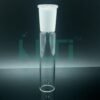As per ASTM standards E – 676
| Part No. | Female Joint | Approx. O.D. of Tube (mm) | Total Length (mm) | Pack QTY. |
| 1070-12F | 12/30 | 16 | 120±10 | 10 |
| 1070-14F | 14/35 | 18 | 120±10 | 10 |
| 1070-19F | 19/38 | 22 | 120±10 | 10 |
| 1070-24F | 24/40 | 28 | 125±10 | 10 |
| 1070-29F | 29/42 | 32 | 135±15 | 10 |
| 1070-34F | 34/45 | 38 | 135±15 | 10 |
| 1070-45F | 45/50 | 50 | 150±15 | 10 |
Potential Uses in the Laboratory:
- Standardized Laboratory Glassware:
- ASTM standards ensure that the glassware meets specific criteria for quality, dimensions, and interchangeability. This is important for standardization in laboratories.
- Precision Experimentation:
- Taper-ground joints provide a secure and reliable connection between glass components. This is crucial for experiments where airtight or leak-free connections are required.
- Modular Setups:
- The interchangeable nature of the joints allows for flexibility in assembling modular laboratory setups. Researchers can easily swap or replace components as needed.
- Routine Laboratory Procedures:
- Such glassware might be used in routine laboratory procedures where standardized and interchangeable components are advantageous.
- Chemical Synthesis and Analysis:
- Taper-ground joints are commonly used in chemical synthesis and analysis where precise control of reactions and the ability to connect different glassware pieces are essential.







